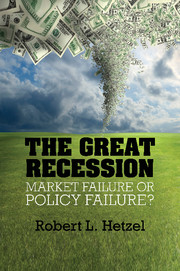Book contents
- Frontmatter
- Contents
- Figures
- Tables
- Preface
- One The 2008–2009 Recession
- Two Recessions
- Three The Great Contraction
- Four Monetary Policy and Bank Runs in the Great Depression
- Five Vigorous Recovery and Relapse
- Six Interwar International Monetary Experiments
- Seven Identifying the Shocks that Cause Recessions
- Eight From Stop-Go to the Great Moderation
- Nine Controlling Bank Risk Taking
- Ten The Housing Crash
- Eleven Bubble Trouble
- Twelve What Caused the Great Recession of 2008–2009?
- Thirteen What Caused the Great Leverage Collapse?
- Fourteen The Distinctions Between Credit, Monetary, and Liquidity Policy
- Fifteen Fed Market Interventions
- Sixteen Evaluating Policy
- Seventeen The Business Cycle
- Eighteen Why Is Learning So Hard?
- Nineteen How Should Society Regulate Capitalism?
- Postscript
- Bibliography
- Index
Five - Vigorous Recovery and Relapse
1933–1939
Published online by Cambridge University Press: 05 May 2012
- Frontmatter
- Contents
- Figures
- Tables
- Preface
- One The 2008–2009 Recession
- Two Recessions
- Three The Great Contraction
- Four Monetary Policy and Bank Runs in the Great Depression
- Five Vigorous Recovery and Relapse
- Six Interwar International Monetary Experiments
- Seven Identifying the Shocks that Cause Recessions
- Eight From Stop-Go to the Great Moderation
- Nine Controlling Bank Risk Taking
- Ten The Housing Crash
- Eleven Bubble Trouble
- Twelve What Caused the Great Recession of 2008–2009?
- Thirteen What Caused the Great Leverage Collapse?
- Fourteen The Distinctions Between Credit, Monetary, and Liquidity Policy
- Fifteen Fed Market Interventions
- Sixteen Evaluating Policy
- Seventeen The Business Cycle
- Eighteen Why Is Learning So Hard?
- Nineteen How Should Society Regulate Capitalism?
- Postscript
- Bibliography
- Index
Summary
As Fortune (1934, 122) wrote, “[T]he fundamental conviction upon which the New Deal was based was the conviction that Something Can Be Done About It [the Depression] – that it is not necessary to submit to the natural laws of economics as an animal submits to the chances of the weather.” The “natural laws of economics” did not require “liquidation” to restore a balanced structure of prices and costs. The common objective of the initiatives undertaken by Roosevelt in 1933 was to raise “prices.” He did not distinguish between the price level and relative prices like commodity prices and real wage rates. Some programs like the National Industrial Recovery Act passed in June 1933, with its price-fixing provisions, undoubtedly hindered recovery. However, the change in the monetary standard, which replaced monetary contraction with expansion, created the economic recovery that began in March 1933.
In early 1933, rumors that the incoming Roosevelt administration would devalue the dollar engendered outflows of gold. George Harrison, governor of the New York Fed, told his directors that the crisis “represents in itself a distrust of the currency and is inspired by talk of devaluation of the dollar” (cited in Eichengreen 1995, 328). Just as in 1893, fear of dollar devaluation and inflation was deflationary through the monetary contraction created by the loss of gold, given that the Fed did not sterilize the depressing effect of the outflows on bank reserves but rather raised the discount rate in February 1933 from 2.5 percent to 3.5 percent. In contrast, with the floating of the dollar in March 1933, the resulting expectation of dollar devaluation and inflation created monetary stimulus instead of contraction, albeit initially in a fitful way.
- Type
- Chapter
- Information
- The Great RecessionMarket Failure or Policy Failure?, pp. 65 - 84Publisher: Cambridge University PressPrint publication year: 2012

